Growing from seeds
Bolivian begonia is an annual flower. It is grown from seeds, planted in open ground with seedlings.
- Seeds are sown in late winter - early spring.
- Seeds (in granules) are laid out on the surface of a moist, loose soil. You can place an even layer of calcined sand on the soil surface and lay out granules on it.
- Moisten the seeds regularly by spraying, avoiding drying out.
- In order for the sprouts to hatch, you need to create a "mini-greenhouse" for them - cover it with a transparent material (glass, cellophane film, plastic) and place it in a well-lit warm place. Open the "greenhouse" for a short time every day, spray the seeds as needed.
- After 13-15 days, seedlings can be expected to appear. For this, the soil must be at a temperature of at least +20 Celsius.
- It is recommended to transplant seedlings after the leaves appear. Seedlings are placed in cassettes with soil 3 cm deep, while the temperature should be reduced by 2-4 degrees.
- The grown seedlings will need to be transplanted again: in a container about nine centimeters deep (reduce the temperature to 15 degrees Celsius).
- It is best to lengthen the daylight hours for seedlings with the help of special lamps.
- The seedlings are "relocated" to the open ground after a steady warmth and there is no risk of sudden freezing. You can also take out potted plants to the balcony or patio.
Bolivian begonia is a charming and easy-care plant. By following simple guidelines, you can grow it at home or on a plot and enjoy its beauty all summer long.
Tuberous (Tuberhybrida)
These are unpretentious perennial plants. They have amazing looks, are versatile and extremely popular. Tuberous begonias owe their name to the fact that they form underground roots in the form of a tuber, with the help of which they reproduce.
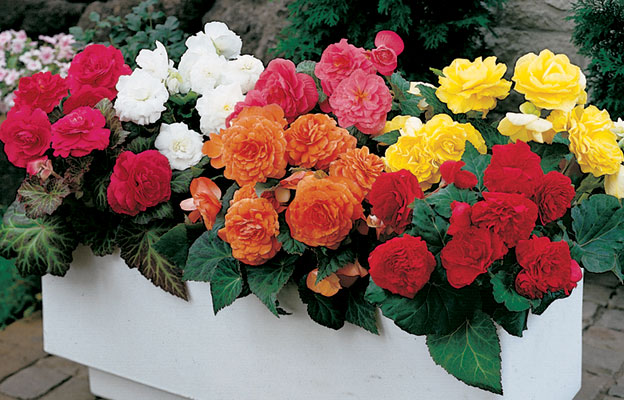
Begonia Grandiflora mix
The most popular variety is the large-flowered begonia (Begonia x tuberhybrida grandiflora) with brightly colored large double flowers that look a bit like roses. Inflorescences in the open field can open up to 20-30 cm in diameter, although when grown indoors they are much more modest. It is difficult to describe in words what the flowers of tuberous begonias look like. Flowers come in all shades of white, yellow, orange, pink, red and burgundy. Two-tone colors are not uncommon, for example, pink with a dark red border.

Begonia Dark Red
Semi-spreading bush, no higher than 16 cm. Bright green leaves are edged with a thin purple border. The flowers are large, double, deep dark red. Their diameter is about 10 cm. They resemble peonies in shape.
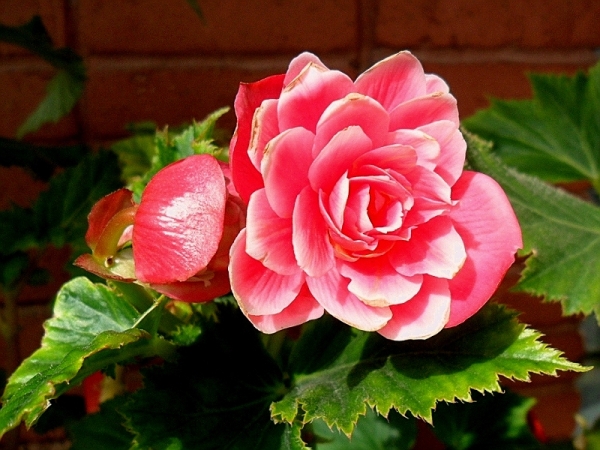
Begonia Camelia Flora
It is a small bush, up to 25 cm in height. The leaves are green. It is characterized by large double flowers (up to 12 cm) pink and white edging along the edge of the petals. The shape of the bud resembles a camellia. The petals have a tiled arrangement.

Begonia "Rosebud" (Begonia Bouton de Rose)
Large, up to 18 cm in diameter, double flowers of this variety are similar to delicate roses due to the fact that in the center of each bud there is a group of petals rolled like rosebuds. White-pink petals are bordered with bright pink edging.

Begonia "Crispa Marginata White-Red"
A very elegant bush with simple wide-oval corrugated flowers, 9 by 12 cm in size. The petals of this begonia are rounded, painted white. They overlap each other in tiles. A bright pink-red border runs along the edges of the leaves. The outer petals are wide, the lateral ones are slightly narrower, and the edges of the petals are wavy, strongly corrugated, like ruffles. A very spectacular bush.
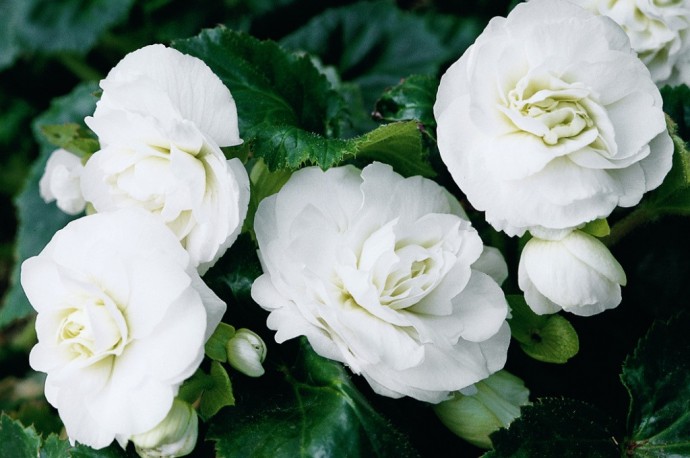
Begonia "Diana Wynyard" (Diana Wynyard)
This is a small bush about 20cm tall... The leaves are pale green. Large (diameter about 20 cm) densely double fringed flowers consist of wavy folded white petals.

Begonia "Marmorata"
The height of the compact bush is about 20-30 cm. The leaves are heart-shaped, openwork, bluish-green.Terry large (about 12 cm) white flowers are decorated with pinkish-crimson strokes and an elegant border of dark cherry color along the wavy edges of the petals. Flowering is profuse and long lasting.

Begonia Golden Wave
In this variety, double flowers are yellow with a border along the edge of the petals in bright orange.
Some groups of tuberous begonias have common similarities in the structure of the bush and the shape of the leaf and inflorescences. They differ in the color of the buds.
Picotee
This group of begonias is considered a real miracle of nature. It differs from other representatives of this species in a special, two-colored color of inflorescences. During flowering, which begins in late spring and ends in mid-autumn, the bush is covered with many large flowers. The petals have a graceful fringe and follow in tiers, like those of cones of scales. The leaves are dark green. Check out some of the varieties in the photo gallery:
Fimbriata
This is not a variety, but a whole group of begonias, which have double, heavily stuffed inflorescences with many fringed petals. The flowers are so lush and full, and the petals have such cut edges that the opened bud looks more like a large carnation than a begonia. The height of the bush does not exceed 25 cm.The following five varieties differ only in the color of the petals:
Terry (Double)
In the next series, tuberous begonias with compact bushes 35-50 cm in height were selected. Their stems are slightly pubescent. Leaves are deep green in color, medium size. The flowers are double, rather large, with a characteristic color for the variety:
How is it grown?
Ampel-type strawberries are grown in different ways - in pots, pots, vases, vertical cassettes, pyramids. The latter are built from any available means - barrels, pots, etc. This culture is also used to decorate lawns, forming bushes into trellises.
The plant looks great in winter gardens, on balconies - you can make a continuously fruiting arch from it. Bushes can also be planted in open ground, but this growing method is used much less often.
Landing requirements
In order for the ampelous strawberry to grow well and bear fruit, it is provided with optimal growing conditions:
- light soils, drained, with neutral acidity (5.2-5.5 pH);
- 8-10 hours of a sunny day - in a too shady place, the culture may stop fruiting;
- lack of drafts;
- crushed green manures - nasturtium, mustard, rapeseed, phacelia are introduced into the soil used for planting.
When planting ampel varieties, you should not plant seedlings too deep and close to each other.
If the planting is carried out in the ground, and even in early spring, then it is important to prevent it from freezing on the soil by covering it with a film or other covering material
Planting methods and instructions for them
Seedlings are usually planted in April-May or August. Ways of growing ampelous strawberries:
-
In pots. For planting, such a capacity is selected so that one adult plant has 1500 cubic meters. see soil. Next, they begin to prepare the substrate, it is prepared from sand - 1 part, sod land - 3 parts, peat - 6 parts. To improve fertility, the soil is fed with organic matter. You can also buy ready-made primer - in a specialized store. In order for the seedlings to take root as soon as possible, they are removed to a dark place before planting, having dug in the ground. There are no special requirements for the pot, the main condition is a height of 30 cm. Holes are made in the bottom so that excess water flows out. Next, the landing order:
- A thin drainage layer is laid at the bottom of the pot. Expanded clay, pebbles, broken brick will do. The prepared soil mixture is laid on top.
- The seedling is immersed in a container - the roots should be placed vertically, and sprinkled with earth.
- Seedlings planted in pots are watered abundantly.
- On the grate. Saplings are planted in open ground. A lattice, a grid, a wicker fence are installed nearby. An overgrown mustache is tied to the lattice structure. The minimum construction height is 1 m.When planting seedlings in open ground, the minimum distance between them is 30-35 cm.
Pyramid. A pyramidal structure is constructed from boxes of different sizes. For example, they take boxes of this size - 20x20x20 cm, 30x30x30 cm and 60x60x60 cm. Having placed the boxes on top of each other, they are filled with earth.
Vertical beds. One of the ways to grow ampelous strawberries in greenhouses. The beds are most conveniently made from inexpensive plastic pipes - they are installed vertically in the greenhouse. The diameter of the pipes is about 50 cm. Holes with a diameter of 25 cm are made in them. The pipes are filled with a nutrient substrate, irrigation is supplied to them, and then the seedlings are planted. You can also grow strawberries in vertically suspended plastic bags that are filled with substrate. Plants are planted in holes previously made in polyethylene. 
method of growing ampelous strawberries "in pots"
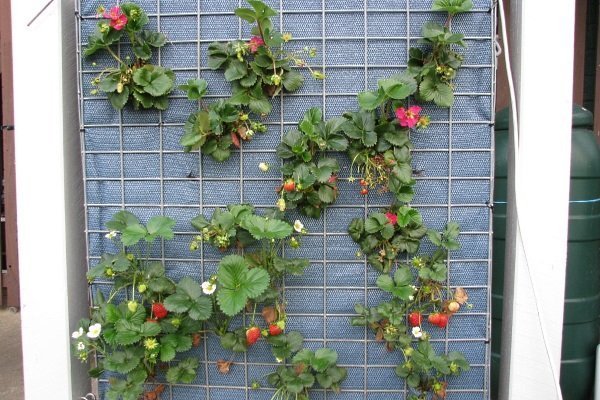
cultivation of strawberries "on a wire rack"

planting strawberries in "pyramid" beds

"Vertical beds" (growing strawberries in bags)
Let's suppose that it is decided to plant strawberries in pots with a capacity of 3 liters with further cultivation in a greenhouse. Work order:
- Place pots with a difference in height - 70-80 cm. If the height of the greenhouse is about 2.5 m, 3 lines of strawberries will fit in it. The intervals between adjacent pots are 40 cm.
- The greenhouse is equipped with drip irrigation.
- The optimum temperature in the greenhouse is 19-25 ° C. At higher temperatures, full pollination does not occur.
- When the plants bloom, the greenhouse is opened - for better pollination of non-self-fertile varieties. If the varieties are self-fertile, then in the greenhouse it is necessary to constantly maintain high humidity - at a level of 90%.
If the area of the greenhouse is 1-2 acres, then the total yield will be 5 buckets, which is half as much as when growing ordinary strawberries.
Common diseases and pests
- Excess moisture is destructive for begonias.
If there is stagnation of moisture in the pot, the plant can rot, its stems and leaves will begin to turn black. It is necessary to remove all blackened parts as soon as possible, treat the begonia with an antifungal agent - fungicide. It is best to change the topsoil to fresh and dry.
- Fungi may appear in watery soil.
Gray rot is most common. It manifests itself in the form of a gray coating on the leaves and mucous - on the buds.
Method of struggle: spraying begonias with a solution of copper sulfate and laundry soap (in one liter of water, stir well two grams of vitriol and twenty grams of soap).
- Powdery mildew is also associated with excess moisture. The leaves are covered with gray spots.
Reference! Homemade "first aid" for powdery mildew: make a solution of laundry soap and gently wipe the leaves. - If the buds fall off, this is an indication of the "overflow" of the plant and / or too dry air.
The actions are obvious: reduce watering and spray more often.
- If the leaves dry and turn yellow, two options are possible.
Either the begonia is "flooded", or, conversely, the soil is too dry. It is required to correct the situation for the better. It may be worth feeding the begonia: there are not enough nutrients for growth and flowering.
- Burns on the leaves? Time to shade the plant or move it to a less lit windowsill.
About why tuberous begonia does not bloom and what to do, as well as about diseases, pests and how to deal with them, read here.
A little about the history of the name of the flower
The homeland of the evergreen shrub plant Lantana is considered the territory of Latin America. Now it is common in tropical and subtropical regions of America, Asia and Africa. This plant in places of growth creates impenetrable thickets, displacing all other vegetation on its way. In India, locals jokingly refer to Lantana as the "curse of the planters."But in private estates, it pleases flower growers with its unpretentiousness, violent growth and beauty and an abundance of inflorescences of different shades, which, moreover, exude a magnificent spicy aroma.
The mention of this plant first appeared in 1737 in the scientific work "Genera Plantarum" by the Swedish scientist-botanist and flora taxonomy Carl Linnaeus. The shape of the inflorescences in the form of scutes reminded him of the inflorescences of the viburnum variety Gordovina, especially since the ancient Romans called the viburnum Lantana that way. The name of the flower surfaced again in 1753 in the scientific work "Species Plantarum", where the word Lantana, in Latin "Lantana", was mentioned as the name of a plant genus from the Verbenaceae family. In total, about 150 species of Lanthanum are known, of which only Lantana Camara and its hybrids are cultivated.
Watering and feeding
Seed begonia is a growing process whose success depends on proper follow-up care.
Particular attention should be paid to watering and feeding. The plant loves moist soil, but avoid waterlogging.
Stagnation of water is considered the first cause of the appearance of fungal microflora, which affects the thin roots of still immature seedlings.
It is recommended to keep the container at a slight slope so that the condensation runs down the lid and accumulates in one corner. After 2 weeks from the moment of sowing the seed, the top cover is installed on supports, over time it will be completely possible to remove it. Avoid high temperatures and direct sunlight on the seedlings.

Plant the seeds in low acid soil. Complex fertilizer solutions are suitable for feeding. Moreover, they must have a low concentration of nitrogen. The first feeding can be done after 14 days from the moment of sowing the seed of the tuberous begonia.
3 Growing seedlings
Since begonia sprouts are very small, threadlike, it can be difficult to notice them. For their correct development, regular watering is necessary.
This is done carefully, from a syringe, or humidification is carried out in the lower way through the tray. The greenhouse in which the seedlings develop must be regularly opened to ventilate and remove condensate.
It is imperative to provide high-quality lighting, but make sure that direct sunlight does not fall on the plants. To do this, at noon, you need to shade the sprouts. If the daylight hours are short, it is necessary to artificially illuminate the seedlings. Daylight hours should be at least 12 hours.

Two weeks after the emergence of seedlings, it is necessary to apply fertilizer for decorative deciduous plants. In this case, it is necessary to make a solution of concentration 3-4 times less than the recommended one. After the seedlings get a little stronger, the earth can be periodically loosened. Gradually, the shelter is removed and the grown begonia is accustomed to indoor conditions.
How to grow purslane from seeds at home?
3.1 Pick
If peat tablets were used to germinate the seed, then picking is not necessary. You just need to tear off the tablet shell from the bottom edge and transplant the seedlings into a larger container along with the soil.
For seedlings grown in a container, picking is mandatory, since over time it becomes cramped for them in one container. The procedure is carried out after the appearance of the third true leaf, if the plant looks healthy and strong:
- 1. Make holes in the plastic cups from the bottom and pour a layer of drainage.
- 2. The containers are filled with soil in which the seeds were germinated.
- 3. The sprouts are gently pry with a teaspoon and transferred into a glass with soil along with an earthen lump. After moving, be sure to water the plants.
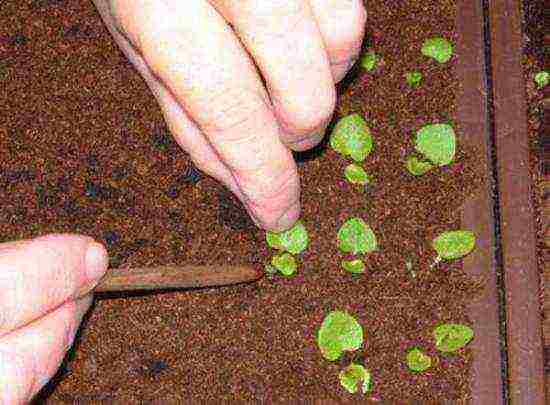
The seedlings are placed in a warm place, but so that they do not stretch out, the temperature can be slightly lowered. Two weeks later, make another top dressing. 25 days after picking, the seedlings can be planted in a permanent place in a pot or garden.
The best ampel varieties
Previously, much was not required from ornamental strawberry varieties - if only they grew and were beautiful. Today, breeders have bred dozens of varieties that are not only decorative, but also have all the qualities of the best strawberries - they are productive, have tasty fruits, and are resistant to viruses, bacteria and fungi.

Table 1 shows the most popular varieties of ampelous strawberries, and their features.
Table 1
|
Variety |
Average weight of berries, g |
Repairability |
Short description |
| Tuscany |
30 |
Yes |
Collection from one bush - 1 kg. A relatively young variety (bred in 2011). The bushes are compact, up to 30 cm in diameter.The length of the shoots reaches 1 m. |
| Temptation F1 * |
15-25 |
Yes |
On an adult bush, up to 20 peduncles are formed. The fruits are large and juicy. Harvesting begins one month after flowering. The pulp is sweet, firm, and has a pleasant smell. Up to 1.2 kg of berries are harvested from the bush. |
| Queen Elizabeth II |
30-40 |
Yes |
The variety is acclimatized in Russia. The fruit has a regular conical shape. The color is deep red, the skin is smooth, glossy. Bears fruit 2-3 times per season. Transplant - every 1.5 years. |
Cletter star
40-50
Yes
High resistance to drought and frost. Able to endure winters without shelter. The bushes are compact, with a lot of whiskers. Peduncles bend downward under the weight of the fruit. the fruits are juicy, bright red, with a strong aroma. The fruits tolerate transportation well. Temptation
30
Yes
Bushes are small, densely leafy. Peduncles are long, with large flowers. The berries are large, oblong, conical, bright red. The aroma has nutmeg notes. High frost resistance. Poorly tolerates heat and drought. Harvest - 1.5 kg.
Geneva
45-50
Yes
Bushes are medium-sized, spreading. They are not placed close to each other - the bushes need space. Tightness increases the risk of gray mold damage. There are few whiskers - about 7 pieces per plant. The shape of the berries is a truncated cone. The surface is glossy, red. The pulp is juicy and aromatic. The taste is sweet, no sourness. The main difference of the variety is the ability to bear fruit for a long time in one place, not 5-2 years, but 5-6 years.
Ostara
50-60 (first berries), then 15-30
Yes
A reliable variety in which fruits are set regardless of the length of daylight hours. The variety is fast-growing. The height of the bushes is 25 cm. The first berries appear in June, the bulk of the crop is 80%, ripens in August-September. One bush gives 1.2 kg of berries. The peculiarity of this variety is the harvest on the bushes growing from the mustache. They separate from the mother bush, take root, and bear fruit. The maximum size of berries is 75 g. Taste is sweet and sour, aromatic. Berries become smaller during the season.
Eternity S1 **
10-15
Yes
Harvest per bush - 0.5 kg. A variety for amateur gardeners. Fruiting - from early summer to frost. Feature - pink flowers. The variety is winter-hardy, resistant to drought, pests and diseases.
Fresco
20
Yes
Fruiting from June to September. The fruits are not large, but numerous. The taste is sweet and sour, the aroma is strong, the pulp is dense, but juicy. Feature - firmly tolerates temperature changes, high immunity. Pink miracle
20-30
long fruiting period
Pineapple type hybrid. Delicious berries. Bushes are powerful, with pink flowers. The variety is frost-resistant, with high immunity. The berries are harvested as they ripen.
Elsanta
40-45
Yes
High-yielding variety - 2 kg of berries are harvested from one bush. The surface is shiny, glossy. The first berries have light ends. The berries are medium to large. The stalk comes off easily.
* F1 symbol means that the plant is a hybrid, obtained by crossing two different varieties. No seeds are harvested from the hybrid for further cultivation. Since it is unlikely that it will be possible to get a good harvest from such seeds, and other positive qualities will also not be passed on to the next generation.
** Symbol S1 denotes the first generation of a varietal plant. Simply put, S1 is a seed harvested from the 1st year of a varietal plant. S2 is the generation from S1.S1 has higher yields and other indicators than S2, and so on.


